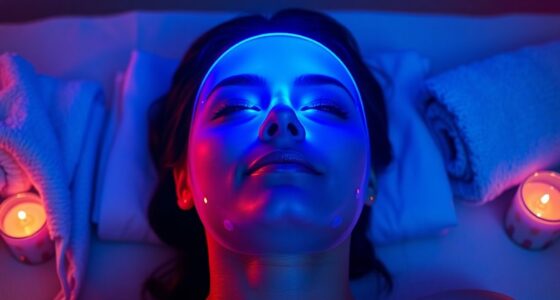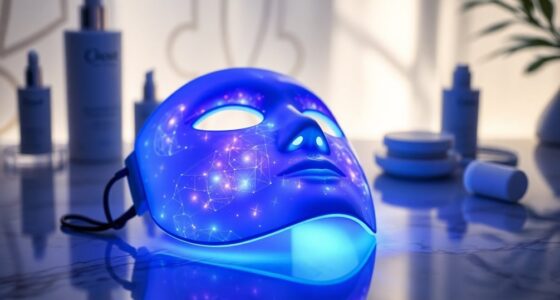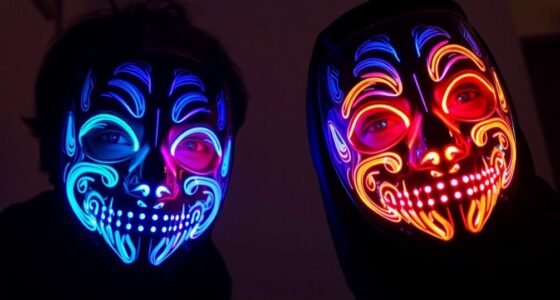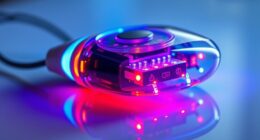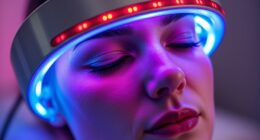LED masks are generally safe for most people, emitting low-energy light that doesn’t damage your DNA. However, you should take precautions, especially if you have darker skin tones or a history of skin issues. Eye protection is essential, especially against blue light. Always consult a healthcare provider if you’re on photosensitizing medications or have retinal diseases. There are potential risks that you might not hear about—discover what else you should know to stay safe while using these devices.
Key Takeaways
- LED masks are generally safe, emitting low-energy light without the DNA damage risks associated with UV rays.
- Eye protection is crucial during use, especially to prevent potential issues from blue light exposure.
- Individuals with skin cancer history or retinal diseases should consult healthcare providers before using LED masks.
- Caution is advised for darker skin tones, as some may experience discoloration or unwanted reactions.
- Regular dermatologist consultations can help tailor LED mask use to individual skin needs and health backgrounds.

Are LED masks really safe for your skin? When you consider the rising popularity of these devices, it’s essential to dive into their safety profile. Generally, LED masks are safe for most people, as they emit low-energy light that doesn’t cause DNA damage like harmful UV rays. This makes them a go-to option for those looking to enhance skin health. Many of these masks are FDA cleared, which means they meet specific safety standards.
However, while the short-term effects are well understood, the long-term consequences are still somewhat murky.
One crucial aspect to keep in mind is eye protection. It’s recommended to wear protective eyewear during use, especially when exposed to blue light. Direct eye contact with this type of light can lead to potential eye problems, making it wise to take precautions.
If you’re someone who’s a history of skin cancer or retinal diseases, it’s best to consult a healthcare provider before diving into the world of LED masks. They can help you weigh the risks and benefits based on your individual health history.
If you have darker skin, you should also exercise caution. While LED masks promote collagen production and target acne-causing bacteria, some studies suggest that they might cause discoloration in certain skin tones. More research is needed to fully understand how these masks interact with various skin types, so it’s wise to be cautious if you belong to this category.
For those taking photosensitizing medications, the same advice applies. Consulting a healthcare provider is essential to ensure that there are no adverse reactions that could compromise your skin health.
While LED masks can be an excellent addition to your skincare routine, understanding your unique skin needs and health background is crucial for safe usage. It’s important to consider factors such as skin type, sensitivity, and any pre-existing conditions before incorporating LED masks into your regimen. Consulting with a skincare professional can provide tailored advice and enhance LED masks effectiveness for skin treatment. By being informed and cautious, you can maximize the benefits while minimizing potential risks to your skin health.
Frequently Asked Questions
What Do Dermatologists Say About LED Masks?
Dermatologists generally see LED masks as safe for most users, especially those cleared by the FDA.
They often recommend using eye protection during blue light treatments to prevent potential risks from prolonged exposure.
While at-home masks can offer benefits, you should know they’re usually less powerful than professional devices, leading to subtler results.
If you have darker skin, consulting a dermatologist first is a good idea to avoid possible pigmentation changes.
Consistency is crucial for noticeable results.
Are There Risks to LED Face Masks?
While LED face masks can offer rejuvenation, they also carry potential risks. You might experience skin irritation or increased sensitivity, especially if you have existing skin conditions.
It’s crucial to protect your eyes from blue light exposure, as prolonged use could affect your vision.
Additionally, individuals with darker skin tones may face a higher risk of pigmentation changes.
Weigh these concerns carefully and consult a dermatologist before starting any treatment.
What Does the Mayo Clinic Say About Red Light Therapy?
The Mayo Clinic highlights that red light therapy offers a non-invasive way to enhance your skin health.
It can promote collagen production and reduce inflammation, helping with issues like acne, rosacea, and aging signs such as wrinkles.
While generally safe, it’s essential to follow usage guidelines to avoid side effects.
Consulting a healthcare provider or dermatologist ensures this therapy suits your individual skin needs, especially for optimal results over time.
Do Dermatologists Recommend Red Light Therapy?
Yes, dermatologists often recommend red light therapy for its numerous skin benefits.
It stimulates collagen production, reduces wrinkles, and helps with conditions like rosacea and acne. They suggest using FDA-cleared devices for safety and efficacy.
For the best results, you’re encouraged to use the therapy 3 to 5 times a week over a few months.
However, if you have specific skin conditions or sensitivities, consulting your dermatologist before starting treatment is a smart move.
Conclusion
So, before you slip on that glowing LED mask, remember it’s not all sparkles and radiance. While many users rave about their skin-transforming powers, you might still want to consult a dermatologist first. Think of it like stepping into a sci-fi movie: the lights flicker, the colors dance, and you’re hoping for a beauty miracle. But just like any high-tech gadget, it’s crucial to know the science behind it to avoid any unexpected side effects. Your skin deserves the best!


